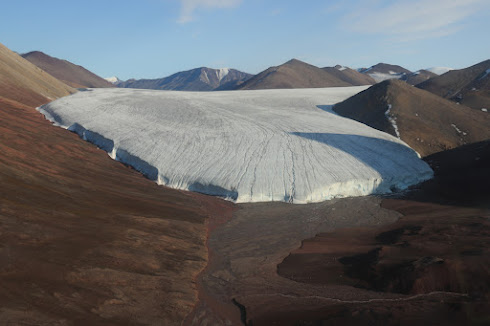I have been reading this article about Thores Glacier in northern Ellesmere Island -- a classic cold-based glacier in the far north. It appears very stable at the moment -- which makes a nice change. The reason for its stability is that the glacier is frozen to its bed, with velocities of between 14 m per year and 26 m per year. That's very slow. So there is hardly any basal sliding going on, and all movement is by internal deformation. The glacier is just 360m thick at its thickest point. The ice cliffs at the front of the glacier lobe are about 60m high.
The authors are concerned because they have discovered that the equilibrium line is rising -- this will reduce the accumulation zone surface area and will increase the tendency of surface drainage to find its way into the body of the glacier and maybe down to the bed.
I'm intrigued by the extraordinary cleanliness of the ice -- hardly any surface debris can be seen, and there is very little on the bed. That means there is hardly any erosion going on. Note too that the glacier is located in an area of very subdued terrain. There are no steep slopes overlooking the glacier flanks -- this means that no rockfall debris is finding its way onto the glacier surface. In any case this is an area of continuous permafrost -- so the freeze-thaw environment is not a very dynamic one.
It's a frozen landscape, and a stark contrast to the dynamism of glacier environments in the uplands of the middle latitudes.
Slow change since the Little Ice Age at a far northern glacier with the potential for system reorganization: Thores Glacier, northern Ellesmere Island, Canada (2022)
Kochtitsky, W. et al Arctic Science11 November 2022
https://doi.org/10.1139/as-2022-0012

No comments:
Post a Comment